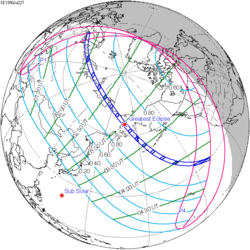Top Qs
Timeline
Chat
Perspective
Solar eclipse of April 20, 2023
From Wikipedia, the free encyclopedia
Remove ads
A total solar eclipse occurred at the Moon’s ascending node of orbit on Thursday, April 20, 2023,[1] with a magnitude of 1.0132. It was a hybrid event, a narrow total eclipse, and beginning and ending as an annular eclipse. A solar eclipse occurs when the Moon passes between Earth and the Sun thereby totally or partly obscuring the Sun for a viewer on Earth. A hybrid solar eclipse is a rare type of solar eclipse that changes its appearance from annular to total and back as the Moon's shadow moves across the Earth's surface.[2] Totality occurs between the annularity paths across the surface of the Earth, with the partial solar eclipse visible over a surrounding region thousands of kilometres wide.[3] Hybrid solar eclipses are extremely rare, occurring in only 3.1% of solar eclipses in the 21st century.[4] Occurring about 4.1 days after perigee (on April 16, 2023, at 3:20 UTC), the Moon's apparent diameter was larger.[5][6]
Totality for this eclipse was visible in the North West Cape peninsula and Barrow Island in Western Australia, eastern parts of East Timor, as well as Damar Island and parts of the province of Papua in Indonesia.[7] A partial eclipse was visible for parts of Antarctica, Australia, Oceania, and Southeast Asia. More than 20,000 people watched the eclipse from the town of Exmouth on Western Australia's North West Cape.[8] Providing infrastructure and services for the visitors (Exmouth's normal population is less than 3,000) cost the State Government of Western Australia A$20 million (US$13.5 million). The date marked a significant moment of astrotourism and tourism in Western Australia.[9]
Remove ads
Images
Animated path of the eclipse
Animation of images from Himawari 9 showing the Moon's shadow moving across the Earth.
Eclipse timing
Places experiencing total eclipse
Places experiencing partial eclipse
Remove ads
Gallery
Australia
- Video of totality from Exmouth, Western Australia
- Partial from Perth, Western Australia, 03:19 UTC
East Timor
- The eclipse shortly before totality, from Timor-Leste (East Timor)
- Totality from East Timor
Indonesia
- Partial from Tasikmalaya, West Java, 03.31 UTC
- Partial from Jakarta, 03:47 UTC
- Partial from Palangka Raya, Central Kalimantan, 04:02 UTC
- Partial from Pangkal Pinang, Bangka Belitung Islands, 04:05 UTC
Malaysia
Philippines
- Partial from San Fernando, Pampanga, 04:50 UTC
- Partial from San Jose del Monte, Bulacan, 04:55 UTC
- Partial from Novaliches, Quezon City, 04:49 UTC
Vietnam
- Partial from Ho Chi Minh City, 04:21 UTC
Eclipse details
Summarize
Perspective
Shown below are two tables displaying details about this particular solar eclipse. The first table outlines times at which the Moon's penumbra or umbra attains the specific parameter, and the second table describes various other parameters pertaining to this eclipse.[10]
Remove ads
Eclipse season
This eclipse is part of an eclipse season, a period, roughly every six months, when eclipses occur. Only two (or occasionally three) eclipse seasons occur each year, and each season lasts about 35 days and repeats just short of six months (173 days) later; thus two full eclipse seasons always occur each year. Either two or three eclipses happen each eclipse season. In the sequence below, each eclipse is separated by a fortnight.
Remove ads
Related eclipses
Eclipses in 2023
- A hybrid solar eclipse on April 20.
- A penumbral lunar eclipse on May 5.
- An annular solar eclipse on October 14.
- A partial lunar eclipse on October 28.
Metonic
- Preceded by: Solar eclipse of July 2, 2019
- Followed by: Solar eclipse of February 6, 2027
Tzolkinex
- Preceded by: Solar eclipse of March 9, 2016
- Followed by: Solar eclipse of June 1, 2030
Half-Saros
- Preceded by: Lunar eclipse of April 15, 2014
- Followed by: Lunar eclipse of April 25, 2032
Tritos
- Preceded by: Solar eclipse of May 20–21, 2012
- Followed by: Solar eclipse of March 20, 2034
Solar Saros 129
- Preceded by: Solar eclipse of April 8, 2005
- Followed by: Solar eclipse of April 30, 2041
Inex
- Preceded by: Solar eclipse of May 10, 1994
- Followed by: Solar eclipse of March 30, 2052
Triad
- Preceded by: Solar eclipse of June 19, 1936
- Followed by: Solar eclipse of February 18, 2110
Solar eclipses of 2022–2025
Saros 129
This eclipse is a part of Saros series 129, repeating every 18 years, 11 days, and containing 80 events. The series started with a partial solar eclipse on October 3, 1103. It contains annular eclipses from May 6, 1464 through March 18, 1969; hybrid eclipses from March 29, 1987 through April 20, 2023; and total eclipses from April 30, 2041 through July 26, 2185. The series ends at member 80 as a partial eclipse on February 21, 2528. Its eclipses are tabulated in three columns; every third eclipse in the same column is one exeligmos apart, so they all cast shadows over approximately the same parts of the Earth.
The longest duration of annularity was produced by member 34 at 5 minutes, 10 seconds on October 4, 1698, and the longest duration of totality will be produced by member 58 at 3 minutes, 43 seconds on June 25, 2131. All eclipses in this series occur at the Moon’s ascending node of orbit.[11]
Metonic series
The metonic series repeats eclipses every 19 years (6939.69 days), lasting about 5 cycles. Eclipses occur in nearly the same calendar date. In addition, the octon subseries repeats 1/5 of that or every 3.8 years (1387.94 days). All eclipses in this table occur at the Moon's ascending node.
Tritos series
This eclipse is a part of a tritos cycle, repeating at alternating nodes every 135 synodic months (≈ 3986.63 days, or 11 years minus 1 month). Their appearance and longitude are irregular due to a lack of synchronization with the anomalistic month (period of perigee), but groupings of 3 tritos cycles (≈ 33 years minus 3 months) come close (≈ 434.044 anomalistic months), so eclipses are similar in these groupings.
Inex series
This eclipse is a part of the long period inex cycle, repeating at alternating nodes, every 358 synodic months (≈ 10,571.95 days, or 29 years minus 20 days). Their appearance and longitude are irregular due to a lack of synchronization with the anomalistic month (period of perigee). However, groupings of 3 inex cycles (≈ 87 years minus 2 months) comes close (≈ 1,151.02 anomalistic months), so eclipses are similar in these groupings.
Remove ads
References
External links
Wikiwand - on
Seamless Wikipedia browsing. On steroids.
Remove ads




























































































































